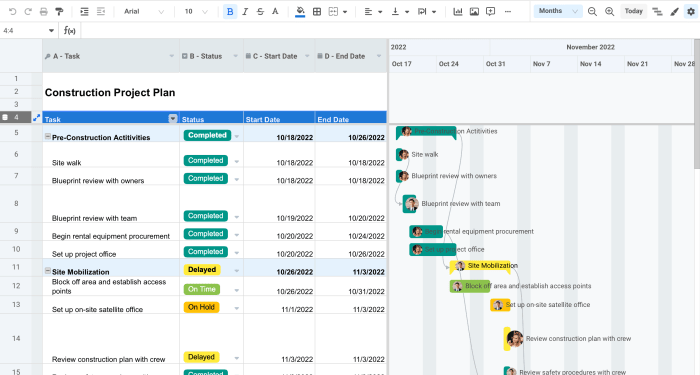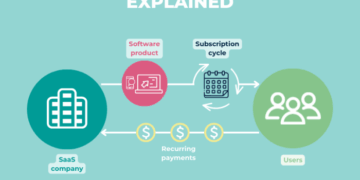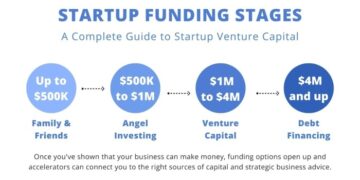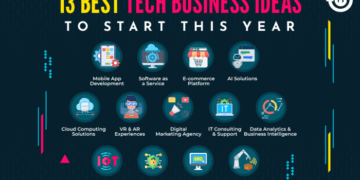Exploring the realm of project management software opens up a world of possibilities for enhanced efficiency and streamlined workflows. This guide delves into the intricacies of utilizing these tools to their full potential, offering insights and tips for a more productive project management experience.
As we embark on this journey, let's uncover the key aspects of project management software and how they can revolutionize the way we approach and execute projects.
Understanding Project Management Software
Project management software is a tool designed to help teams plan, execute, and manage projects efficiently. It typically includes features such as task management, scheduling, resource allocation, budgeting, and collaboration tools. By centralizing project information and communication, project management software helps streamline workflows and increase productivity.
Key Features of Project Management Software
- Task Management: Assign tasks, set deadlines, and track progress.
- Scheduling: Create project timelines and milestones to ensure timely completion.
- Resource Allocation: Allocate resources effectively to optimize project outcomes.
- Budgeting: Monitor project costs and expenses to stay within budget.
- Collaboration Tools: Facilitate communication and teamwork among project team members.
Benefits of Using Project Management Software
- Improved Communication: Enhances collaboration and ensures all team members are on the same page.
- Efficient Task Management: Helps prioritize tasks, allocate resources, and meet deadlines effectively.
- Increased Productivity: Streamlines workflows, reduces manual tasks, and boosts overall productivity.
Popular Project Management Software Tools
- Asana: Known for its user-friendly interface and robust task management features.
- Trello: Popular for its visual boards and customizable workflows.
- Jira: Ideal for software development teams with advanced issue tracking and agile project management capabilities.
- Monday.com: Offers a versatile platform for project planning, tracking, and collaboration.
Streamlining Workflows and Increasing Productivity
Project management software plays a key role in streamlining workflows by providing a central hub for project information, task assignments, and progress tracking. By automating repetitive tasks, facilitating communication, and offering real-time updates, project management software enables teams to work more efficiently and focus on delivering successful project outcomes.
Getting Started with Project Management Software
When embarking on the journey of using project management software, it is crucial to choose the right one that aligns with your specific needs and requirements. Here are the steps to get started with project management software effectively:
Choosing the Right Project Management Software
Before diving into project management software, take the time to assess your needs and goals. Consider factors such as team size, project complexity, budget, and integration requirements. Research different software options and read reviews to make an informed decision.
Setting Up a Project in the Software
Once you have selected the project management software, the next step is to set up a project within the platform. This involves creating tasks, assigning responsibilities to team members, and setting deadlines for each task. Ensure clear communication and collaboration among team members to streamline the project workflow.
Importance of Customization and Configuration
Customization and configuration options in project management software play a vital role in tailoring the software to meet your specific project needs. Customizing workflows, task lists, and reporting features can enhance efficiency and productivity. Take advantage of these options to optimize the software for your project requirements.
Utilizing Features for Efficiency
When it comes to project management software, utilizing its features efficiently can make a significant difference in the success of your projects. By exploring and leveraging different tools available, such as Gantt charts, Kanban boards, and task dependencies, you can streamline your project management process and improve overall efficiency.
Gantt Charts
Gantt charts are visual representations of project timelines, showing tasks, deadlines, and dependencies. By using Gantt charts effectively, you can track progress, identify bottlenecks, and allocate resources efficiently. Make sure to update your Gantt chart regularly to reflect any changes in the project timeline.
Kanban Boards
Kanban boards are great for visualizing workflows and managing tasks in a more agile way. To maximize efficiency with Kanban boards, create clear task categories, limit work in progress, and prioritize tasks based on their importance and urgency. This helps in maintaining focus and ensuring tasks are completed in a timely manner.
Task Dependencies
Task dependencies help in defining the sequence in which tasks need to be completed. By setting up task dependencies correctly, you can ensure that tasks are executed in the right order, avoiding delays and confusion. Identify critical paths within your project to prioritize tasks effectively and optimize project timelines.
Collaborating and Communicating with Project Management Software
Efficient collaboration and communication are essential for successful project management. Project management software plays a crucial role in facilitating collaboration among team members and improving communication within a project.
Facilitating Collaboration
Project management software provides a centralized platform where team members can collaborate in real-time, regardless of their physical location. This allows for seamless sharing of information, updates, and feedback, leading to improved teamwork and productivity.
- Team members can access project details, tasks, timelines, and progress updates in one place, promoting transparency and accountability.
- Collaboration features such as task assignments, comments, and mentions allow team members to communicate and coordinate effectively.
- Version control and document sharing features ensure that everyone is working on the latest information, reducing errors and miscommunication.
Communication Tools
Project management software offers a variety of communication tools to streamline interactions among team members:
- Chat:Real-time messaging tools enable instant communication for quick discussions, clarifications, and decision-making.
- Notifications:Automated notifications keep team members informed about project updates, deadlines, and changes, reducing the chances of missing important information.
- File Sharing:Secure file-sharing capabilities allow team members to exchange documents, images, and other project-related files efficiently.
Best Practices for Collaboration
To enhance team collaboration and efficiency, consider implementing the following best practices when using communication features in project management software:
- Encourage open communication and active participation from all team members to ensure everyone is aligned and informed.
- Set clear communication guidelines, including response times, preferred channels, and the use of notifications, to maintain consistency and clarity.
- Utilize project management software integrations with email and calendar tools to streamline communication across platforms and ensure all team members are up-to-date.
- Regularly review and update project communication channels and tools to adapt to changing project needs and team dynamics.
Monitoring Progress and Tracking Metrics
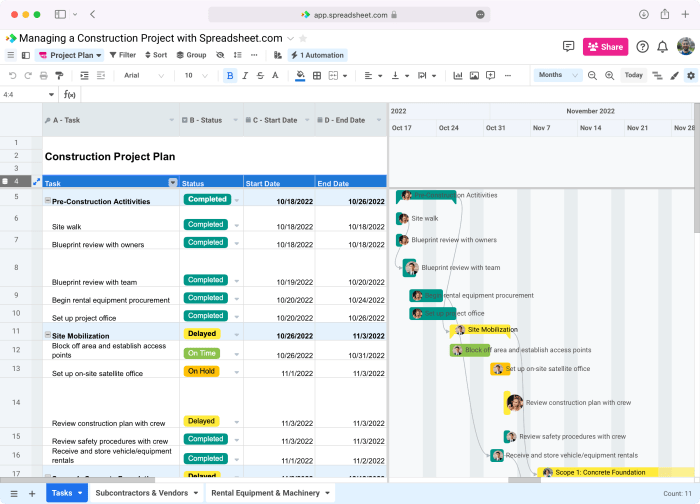
Monitoring progress and tracking key metrics are essential components of effective project management. It allows project managers to stay on top of tasks, deadlines, and overall project performance. By analyzing metrics and data, informed decisions can be made to ensure the project stays on track and adjustments can be made as needed.
Setting Up Progress Tracking and Reporting
- Establish clear project goals and milestones to track progress against.
- Utilize project management software to create Gantt charts, timelines, and progress reports.
- Assign tasks and deadlines to team members to track individual progress.
- Regularly update the project status and progress in the software to keep all team members informed.
Analyzing Metrics for Informed Decisions
- Use the software to track key performance indicators (KPIs) such as budget, timeline adherence, and task completion rates.
- Compare actual progress against planned milestones to identify any discrepancies.
- Identify bottlenecks or areas of improvement based on the data and metrics collected.
- Make data-driven decisions to adjust project plans, resources, or timelines as needed to ensure project success.
Integrating Project Management Software with Other Tools
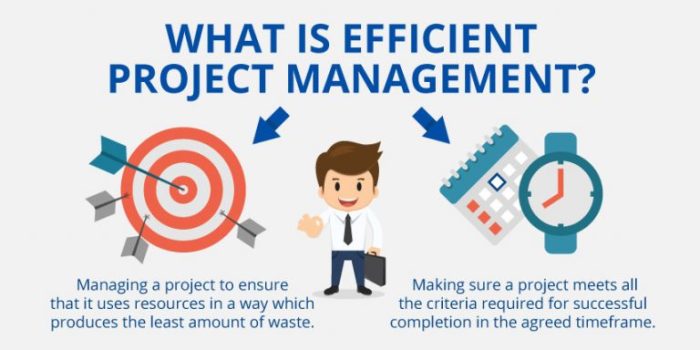
Integrating project management software with other tools can significantly enhance efficiency and streamline workflows. By connecting project management software with tools like calendar apps, time tracking software, and CRM systems, teams can improve collaboration, communication, and overall project outcomes.
Benefits of Integration
- Improved communication: Integrating project management software with communication tools like Slack or Microsoft Teams allows team members to easily share updates, discuss tasks, and collaborate in real-time.
- Efficient time tracking: Connecting project management software with time tracking tools such as Toggl or Harvest enables accurate tracking of time spent on tasks, helping in better resource allocation and project planning.
- Enhanced data visibility: Integrating project management software with CRM systems like Salesforce or HubSpot provides a comprehensive view of customer interactions, enabling better project alignment with client needs.
Examples of Common Integrations
- Integration with Google Calendar: Project management software like Asana or Trello can sync tasks and deadlines with Google Calendar, ensuring team members stay updated on project timelines and milestones.
- Integration with Zapier: Using automation tool Zapier, project management software can be connected with a wide range of applications, automating repetitive tasks and improving workflow efficiency.
- Integration with Slack: By integrating project management software with Slack, teams can receive real-time notifications, discuss project updates, and share files seamlessly within the messaging platform.
Best Practices for Seamless Integration
- Define integration goals: Clearly Artikel the objectives of integrating project management software with other tools to ensure alignment with overall project goals.
- Choose compatible tools: Select tools that offer robust integration capabilities and are compatible with your project management software to facilitate smooth data flow.
- Train team members: Provide training to team members on how to use integrated tools effectively to maximize the benefits of seamless integration.
Final Thoughts
In conclusion, harnessing the power of project management software can lead to unparalleled efficiency and success in project execution. By integrating these tools seamlessly into your workflow and utilizing their features effectively, you can elevate your project management game to new heights.
General Inquiries
How do I choose the right project management software?
To choose the right software, consider factors like your project needs, team size, budget, and desired features before making a decision.
What are some common integrations for project management software?
Common integrations include calendar apps, time tracking software, and CRM systems, which can enhance efficiency and streamline processes.
Why is monitoring progress important in project management?
Monitoring progress helps track project milestones, identify bottlenecks, and ensure timely completion of tasks for successful project delivery.

